Joyce T. Strand's Blog, page 2
December 12, 2017
WHAT THE EXPERTS SAY: Mayra Calvani, Author
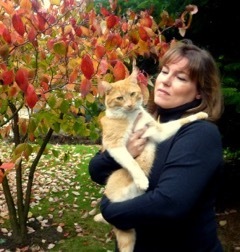 Mayra Calvani with Ramses
Mayra Calvani with RamsesAuthor, MAMA GRACIELA'S SECRETMayra Calvani recently released her latest children’s book MAMA GRACIELA’S SECRET for three-to-seven year olds about the efforts of Mama to save her restaurant from being closed by an inspector due to her large number of cats. Reviewers say it’s “a picture book with character, voice and story.” Calvani, who also writes award-winning adult fiction and non-fiction books, enjoys penning all types of books but appreciates the “quicker gratification” she receives from children stories.
Wishing there were more hours in the day, Calvani is currently doing final revisions on another picture book manuscript and is also working on a YA mythological fantasy novel under pen name Zoe Kalo. She lives in Belgium with her husband, two children, and her three pets.
Q You have written a number of children’s books besides your newest, MAMA GRACIELA’S SECRET. What started you to write children’s books?
Mayra Calvani: First of all, thank you for having me on your blog, Joyce! I fell in love with children’s books after I had children. Before then, I was writing only for adults, but reading picture books to them every night made me fall in love with the genre. I had many ideas for stories so I thought, why not give it a try?
Q: Your newest book, MAMA GRACIELA’S SECRET, has a touch of mystery along with its whimsical side of “TENDER, CRUNCHY, SPICY bacalaitos fritos enjoyed by people and cats from all over the island.” Do you find that a touch of mystery appeals to kids? Or is it all about the magic?
Mayra Calvani: You must be referring to the scene when Mama Graciela gathers all of her cats to help her find a solution so that her restaurant will not be shut down and all the cats taken away. You’re right that there’s a touch of mystery there. It’s kind of a mystical, otherworldly moment because there’s a communication between Mama Graciela and her cats. Who wouldn’t want to communicate with their pet? I suppose there’s also magic in that, not in a literal sense but in a figurative way.
Q: What kind of characters do children relate to? Is Mama Graciela someone that a kindergartner will understand and care about?
Mayra Calvani: Children relate best to children protagonists, but they can also relate to adult characters who have childlike qualities and who have feelings that kids can empathize with. Mama Graciela hasn’t just rescued a few cats. She has rescued one thousand cats! And she will do whatever it takes to protect them. You know what they say, when you save a life, you’re responsible for that life.
Q: You’ve said that MAMA GRACIELA’S SECRET is for children ages kindergartner through SIX. Do you write for different age groups? How do you adapt your story and characters for different ages?
Mayra Calvani: I write fiction and nonfiction for adults and I also write YA fiction under my pen name Zoe Kalo (www.ZoeKalo.com). Language and content set the difference between the various ages groups. The younger the audience, the simpler the language. The older the reader, the more complex and sophisticated the content.
Q: The illustrations in MAMA GRACIELA’S SECRET are special and important for children. How did you meet Sheila Fein? How did you impart to her what you wanted for illustrations? Or do any of the illustrations come first?
Mayra Calvani: It was my publisher, Tannya Derby from MacLaren-Cochrane Publishing, who provided the illustrator, so I didn’t know Sheila before then. She was wonderful to work with and at all stages of the illustrating process I was able to provide feedback. We went back and forth on all the artwork until the completion of the book. At the beginning it took a couple of tries to get the color palette right, one that would fit with the tropical island setting. The same happened with Mama Graciela, but once we had those the rest moved pretty quickly. It was more about the finishing touches than big modifications.
Q: You also write non-fiction and fiction for adults. Do you prefer children’s story over adult fiction and non-fiction?
Mayra Calvani: I love both! They’re so different from each other! The thing with children’s stories, though, is that since they’re short you get quicker gratification because you see the end result--meaning the completed manuscript—sooner. It may take me a few weeks to write, edit and polish a children’s picture book, but it may take me up to two years to finish a novel for adults.
Q: Do you include villains and heroes in your children’s stories? If so, what characteristics do villains have that you find effective?
Mayra Calvani: Yes, I do. In Mama Graciela’s Secret, Mama Graciela is the hero because she selflessly sacrifices her secret recipe to save her cats. The Health Inspector is the villain because he is in the way of Mama Graciela keeping her cats. He wants to shut the restaurant and take away her cats. But he is also doing his job and preventing a health hazard. This is important because successful villains must have a good quality, too.
Q: Do you embed messages in your children’s stories to help teach values to children? Or are your stories strictly for entertainment?
Mayra Calvani: Never only for entertaining. My children’s stories always have a message, but I don’t hit readers over the head with it. Mama Graciela’s story teaches about love for animals, self-sacrifice, decision-making, and ethnicity.
Q: What’s next? What else are you working on?
Mayra Calvani: I’m doing final revisions on another picture book manuscript that I must send to my agent. I’m also working on a YA mythological fantasy novel under my pen name Zoe Kalo. I have many ideas for many more books. If only there were more hours in the day! J
Q: Tell us about Mayra Calvani. What do you like to do when you’re not writing?
Mayra Calvani: I lead a quiet life. I like to think myself as a disciple of writing. But when I’m not writing or revising, I love reading (duh!), journaling, dining and going to the cinema with my hubby, and just spending time with my pets and kids. About Mayra Calvani
Mayra Calvani writes fiction and nonfiction for children and adults and has authored over a dozen books, some of which have won awards. Her children's picture book, Frederico the Mouse Violinist was a finalist in the 2011 International Book Awards; her anthology Latina Authors and Their Muses was a First Place winner at the 2016 International Latino Book Awards; her nonfiction book, The Slippery Art of Book Reviewing, was a Foreword Best Book of the Year winner. Her stories, reviews, interviews and articles have appeared on numerous publications like The Writer, Writer's Journal, Multicultural Review, Bloomsbury Review, and others.
She lives in Belgium with her husband of 30+ years, two wonderful kids, and her three beloved pets. When she's not writing, editing, reading or reviewing, she enjoys walking with her dog, traveling, and spending time with her family. www.MayrasSecretBookcase.com
About the illustrator
Born in Queens, New York and living in Los Angeles since 1987, Sheila Fein has always been
 inspired by the changing world around her. Earning her BA in Design from Buffalo State College of New York, her concentration was on drawing, painting, printmaking, and photography. Sheila's education as an artist has taken her everywhere from Fleisher Art Memorial in Philadelphia to Bath University in England. Today, Sheila Fein runs two figurative workshops, Imaginings Sketch in LA and People Sketchers in Thousand Oaks. She has been featured in numerous collections, magazines, books, solo and group exhibitions. Her paintings and drawings reside in public and private collections. Sheila loves to make the imagination of others a reality and has done so through her commissioned Fein Fantasy Portraits and Interactive Paintings. In addition to being a fine artist Sheila works as an illustrator. She just completed the book "Mama Graciela's Secret" for Maclaren-Cochrane Publishing.
inspired by the changing world around her. Earning her BA in Design from Buffalo State College of New York, her concentration was on drawing, painting, printmaking, and photography. Sheila's education as an artist has taken her everywhere from Fleisher Art Memorial in Philadelphia to Bath University in England. Today, Sheila Fein runs two figurative workshops, Imaginings Sketch in LA and People Sketchers in Thousand Oaks. She has been featured in numerous collections, magazines, books, solo and group exhibitions. Her paintings and drawings reside in public and private collections. Sheila loves to make the imagination of others a reality and has done so through her commissioned Fein Fantasy Portraits and Interactive Paintings. In addition to being a fine artist Sheila works as an illustrator. She just completed the book "Mama Graciela's Secret" for Maclaren-Cochrane Publishing.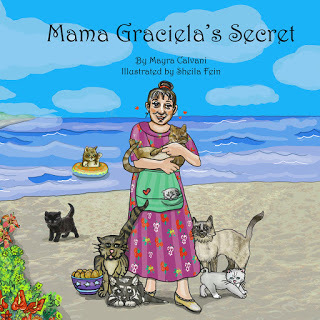 About MAMA GRACIELA’S SECRET
About MAMA GRACIELA’S SECRETMamá Graciela’s TENDER, CRUNCHY, SPICY bacalaítos fritos are the best in town... Local customers (including stray cats!) come from all over the island to enjoy her secret recipe. But when the Inspector discovers that Mamá secretly caters to so many cats and he threatens to close her tiny restaurant, Mamá must come up with a plan to save it—and all of the animals she loves.
Links
Amazon
MacLaren-Cochrane Publishing Orders@maclaren-cochranepublishing.comPublishing company Contact Info: MacLaren-Cochrane Publishing 1024 Iron Point Rd 100-1478 Folsom CA 95630 916-897-1670Tannya@Maclaren-cochranepublishing.com www.maclaren-cochranepublishing.com MacLaren-Cochrane Publishing 620 Buchanan Way, Folsom, CA 95630 916-897-1670 www.maclaren-cochranepublishing.com **This book also has version printed in the Dyslexic font, the typeface for people with dyslexia. Go to www.dyslexiefont.com to find out more about the typeface.
Published on December 12, 2017 00:59
November 26, 2017
WHAT THE EXPERTS SAY: Jyoti Arora, Author
 Jyoti Arora, Author
Jyoti Arora, AuthorYOU CAME LIKE HOPE
THE LEMON GIRL
DREAM'S SAKEJyoti Arora brings us her third romance novel, YOU CAME LIKE HOPE, about Peehu who believes no one wants her and has assumed a false identity; and Adih, who hates all women. She writes them as ordinary people who have reached the end of their rope. Although the story is set in India, the novel offers the universal theme of love and romance.
Her first three novels are romance with a social theme. Jyoti next wants to write a purely romance novel without a social theme. Given that she is a patient of Thalassemia Major, she has a special appreciation for technology and the internet, which have enabled her to achieve much of her livelihood.
Q: Why/how does your novel YOU CAME LIKE HOPE fit into the genre of contemporary romance? How is “contemporary” romance different from “traditional” romance?
Jyoti Arora: YOU CAME LIKE HOPE is a romance because its main focus is on the love story. Although it is a realistic fiction with realistic characters, it has several romantic elements and scenes.
Contemporary Romance is a sub-genre of Romance and deals with people and themes that are current and contemporary. So, I labeled YOU CAME LIKE HOPE as a Contemporary Romance because the characters and situations are all based in the current times. The main conflict of the story is also based on a current social issue.
Q: Tell us a summary of your plot. Who are the main characters? What happens to them? (Do not divulge the entire story, but just offer some description of the plot.)
Jyoti Arora:The romance in the book revolves around Peehu and Adih. Peehu believes nobody wants her and has assumed a fake identity. Adih believes he needs nobody and hates all women as cheaters. Love is their only hope of salvation. But it cannot succeed until they overcome the blighting shadow of their past, battle with their fiery emotions, and accept their new realities.
Running parallel to the romance of Peehu and Adih is the tragic history of Adih’s brother Arunav. It is his story, told through tiny chapters (50 – 400 words), that raises the issue of fake cases filed by women.
Q: Did you write YOU CAME LIKE HOPE to entertain your readers or did you intend to deliver some messages and influence your readers?
Jyoti Arora: I wrote YOU CAME LIKE HOPE to deliver a message in an entertaining way. That is why it has a social issue woven in the fabric of a romance.
Q: Do you believe that YOU CAME LIKE HOPE has universal appeal? Will readers world-wide appreciate and relate to it?
Jyoti Arora: Yes, I believe so. Although the location and characters are Indian, the story is such that it can happen anywhere. My heroine believes she is an unlucky loser. My hero hates all women as cheaters. These people can grow up in any country, and still feel the same. The main conflict of the story is a rising social issue in India, but it is not restricted to India.
Besides, YOU CAME LIKE HOPE is a romance. Romances have universal appeal, I feel.
Q: How do your characters engage the reader? Why will readers care what happens to them? Are they super-heroes or ordinary people in extraordinary situations?
Jyoti Arora: My characters are ordinary people hanging at the end of their rope. My heroine, Peehu, feels trapped in the web she herself has created under the mistaken belief of giving happiness to her parents. My hero, Adih, is denying himself all the pleasures of life and youth to take care of his orphan niece. They are both good people caught in bad situations. I believe they will tug at readers’ heart and readers will want them to be together and happy. The story shows that Peehu and Adih need each other. Readers will want them to realize this, stop running away from love and be happy.
Q: Does the concept of hero vs villain apply to your story? What makes an effective villain?
Jyoti Arora: There is no villain that thwarts the hero or heroine at every step. However, there is one woman whose treachery causes a lot of pain to the hero and his family.
As for an effective villain, the ones that I like best are the ones that can chill your heart with one quiet word. A villain that can sway everyone with his cunning is very effective.
Q: What inspired you to write YOU CAME LIKE HOPE? Did you base the characters or events on someone or something in your own life?
Jyoti Arora: I got the idea of writing YOU CAME LIKE HOPE when I got trolled on Twitter one day! My second novel LEMON GIRL is a Feminist Fiction. One of my tweets about it got trolled a lot one day. That’s when I realized that there was an opposite side of the problem I discussed in LEMON GIRL. I decided to write a book about it too and YOU CAME LIKE HOPE developed.
Q: You are also intrigued with the world of technology and have written an award-winning technical blog. Does the world of technology help you to create your stories? Are romantic fiction and technology somehow related?
Jyoti Arora: I don’t know where I’d be today had it not been for the advancement of technology. The magic of internet has done wonders in my life. Due to my medical problems (Thalassemia Major), I live a very home-bound life. I wouldn’t have been able to do much had it not been for the support and opportunities granted by internet.
I don’t think the technology helps me in imagining my stories. But it helps me in everything else. As for relation between technology and romance, well, I don’t think there is much relation. Although, I do use characters inspired by my experience as a tech. blogger. The hero of LEMON GIRLis a Technology Blogger. And one of the characters in YOU CAME LIKE HOPE is developing a smartphone app.
Q: What’s next?
Jyoti Arora: I have written three novels so far: DREAM’S SAKE, LEMON GIRL, and YOU CAME LIKE HOPE. All three had love stories revolving around a serious social issue. I want to try my hand at something purely romantic now, for a change.
Q: Tell us something about yourself. What do you like to do when you’re not writing or blogging?
Jyoti Arora: I am a hopeless bookworm. I fell in love with books ever since I learnt to read. When I am not writing, I am reading mostly. I also enjoy listening to old Bollywood songs, watching English TV shows and Hollywood/Bollywood movies. I used to be good at drawing and handicrafts too, but don’t get the time to indulge in this hobby now. I’m addicted to technology and love talking about it. I’m currently living in Ghaziabad with my parents. And through my writing and the magic on internet, trying very hard to reach the readers worldwide.
Jyoti Arora is a novelist and blogger from Ghaziabad, India. YOU CAME LIKE HOPE is her third novel, coming after DREAM’S SAKE and LEMON GIRL. She is Post Graduate in English Literature and Applied Psychology.
Jyoti has over five years of experience working as a freelance writer. This experience includes abridging over 24 famous English classics like Jane Eyre, Moby Dick etc.
Jyoti Arora is a patient of Thalassemia Major. But she does not let this stop or discourage her. For her determination and achievements, Jyoti has received appreciation from Ms Sheila Dixit, Ms Maneka Gandhi and the Ghaziabad wing of BJP. Her life story has been covered in various local and national TV shows, radio programs, newspapers, magazines and websites like YourStory and Inspire India. She was also one of the ‘100 Women Achievers of India’ that were invited to witness the Republic Day parade of India (2016) as special guests.
Besides reading and writing novels, Jyoti also enjoys blogging and has won several blogging competitions. She loves checking out latest technological innovations, watching movies, and listening to old Bollywood songs. Reach her at jyotiarora.com.
About YOU CAME LIKE HOPE
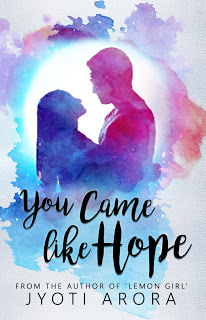 YOU CAME LIKE HOPE tells the love story of a girl who considers herself an unlucky loser and takes up the identity of someone else. Her love interest is a young man who belongs to a family wrongly accused of abusing and torturing a woman. He’s scared of love and happiness and has decided never to trust any woman or think about getting married. Love brings them together and gives them the strength to overcome their weaknesses and fears. More than the fate, they have to fight against themselves to win this love and attain their bliss.
YOU CAME LIKE HOPE tells the love story of a girl who considers herself an unlucky loser and takes up the identity of someone else. Her love interest is a young man who belongs to a family wrongly accused of abusing and torturing a woman. He’s scared of love and happiness and has decided never to trust any woman or think about getting married. Love brings them together and gives them the strength to overcome their weaknesses and fears. More than the fate, they have to fight against themselves to win this love and attain their bliss.LinksPurchase Sites Ebooks Amazon Amazon India iTunes (iOS)Author SitesTwitter: Jy0tiAr0raWebsite/BlogFacebookGoodreads
Paperback: Not yet available, but will come soon on Amazon, Flipkart and PayTM.

document.write('');
Published on November 26, 2017 18:55
November 9, 2017
WHAT THE EXPERTS SAY: Sybrina Durant, Author
 Sybrina Durant, Author
Sybrina Durant, AuthorTHE BLUE UNICORN'S JOURNEY TO OSMSybrina Durant created THE BLUE UNICORN’S JOURNEY TO OSM, targeted at teens, but to be enjoyed by all ages. She thought of the concept almost 40 years ago, and completed her vision recently with an illustrated book that includes unicorns with “personality and depth” and a story that is an “action-packed adventure,” according to reviewers. Durant’s unicorns also display humor, an attribute that Durant believes is critical in our human lives.
She is currently working on a full novel of THE BLUE UNICORN’S JOURNEY TO OSM and also plans to publish a glossary about the characters, places, and things she created in the world of her book. She lives in Texas, and when she’s not writing books, she likes to write songs.
Don’t miss an excerpt from the book following the interview.
Q: What inspired you to write about a blue unicorn? Why choose a unicorn?
Sybrina Durant: Nearly 40 years ago, when I first conceived of the idea for THE BLUE UNICORN’S JOURNEY TO OSM I had read a lot of fantasy books which completely mesmerized me. The ones which really stood out to me were books like “Watership Down” by Richard Adams (which was about a rabbit warren with members who thought and acted like humans), “Dragonriders of Pern” by Anne McCaffrey (with dragons which could speak to humans telepathically), “The Oz” books by L. Frank Baum (with the talking lion, talking monkeys, talking chickens and more), “Alice in Wonderland” by Lewis Carroll (with the talking white rabbit and the Cheshire cat) and oh so many others.
I was fascinated by the idea, throughout all of the different stories, that animals could be reasoning creatures - that they could love and war and exist as communities within themselves or with humans. But I was especially influenced by the unicorns from Phaze in Piers Anthony’s “Apprentice Adept Series”. Those unicorns ranged in a multitude of colors and were as intelligent as humans. They were musical and magical, too. I was also enamored with the word play in Piers Anthony’s writing style. He would take ordinary words and give them completely different but clever meanings. I wanted to try my hand at that style of writing so I set about developing the metal-horned unicorn tribe from Unimaise.
Each would have a different metal horn with coat, mane and tail colors derived somehow from the properties of the metal. For instance, since burning copper has green flames, the copper-horned unicorn is green. The unicorns would each have a different magic power somehow associated with the properties of their metal. Since copper was once used exclusively for water pipes because it was thought to keep water flowing through it clean, the copper-horned unicorn’s magic power is to purify water. That’s the theme I tried to stick with in developing all of the characters but I had to use a lot of poetic license at times. Only one unicorn would be different. He would have no metal and no magic. The story is about the blue unicorn’s quest to save his tribe despite his overwhelming “disabilities”.
After intense research in dictionaries, encyclopedias and real library books, I ended up with index cards for each unicorn and all of the other characters that I wanted to feature in the story. I wrote a very long outline and summary and even drew a detailed map of the land of MarBryn. After typing up about 50 pages of the story, I just came to a screeching halt and didn’t start up again until a couple of years ago. Life just got in the way.
Q: Who are your target readers for THE BLUE UNICORN’S JOURNEY TO OSM?Is this a book for children, young adults, adults? Reviewers say that, “This book transcends age groups.” Do you agree?
Sybrina Durant: Originally, this book was going to be an adult fantasy but after becoming acquainted with the amazingly talented Sudipta Dasgupta, I decided I wanted this to be an illustrated book that could appeal to a younger audience. I had nearly finished the novel by the time he approached me about doing the illustrations. In order to best present his artwork, I realized that I was going to have to minimize the amount of pages and enlarge the page sizes. I went through the very tedious process of reducing the story text so that each chapter would fit into just two pages which would precede a picture spreading across two pages. The best reading experience is definitely the print version but it is available in all ebook formats also. In addition to reducing the word count, I also simplified a lot of the text but I left in many concepts that (in some people’s opinions) placed the book beyond the middle grade age group.
Since many parents wish to protect their children from subjects like war and death as long as possible I decided to rate this book for teens and up. I have tried to write an appealing story for all ages to enjoy but I think it is up to each reader, no matter what their age might be, to decide for themselves about whether it reaches out to them or not.
Q: Did you write THE BLUE UNICORN’S JOURNEY TO OSM strictly to entertain? Or did you intend, as one reviewer says, to write a book “with deeper meanings and themes?”
Sybrina Durant: I have always been interested in the “science of things”. I wanted to bring as much of that into the story as I could to make it a learning experience which was both magical and entertaining at the same time. The further I got into writing the story, it began revealing things to me that I had not anticipated. That long outline I mentioned earlier was thrown out the window. I never really referred back to the summary, either. I redrew a lot of the map and instead of having only one journey line, there are now two. Some characters who were barely even there before became major players. They wanted their stories to become prominent and so they are now. I am very glad that readers have found deeper meanings in the book than they thought they might find when they began reading the story. I guess if the book has a main theme, it is “You can’t judge a book by its cover. You must open it to find what’s within.” That is true for every person, place or thing we come across in our lives. If you give a little of your time and consideration, you will almost always find some reward.
Q: When writing about a unicorn and magic, how do you create believability or credibility? How relevant is consistency in your world-building? What will cause a reader to stop reading?
Sybrina Durant: This story is a blend of magic and realism. Everybody’s got to eat and these unicorns especially love eating. Luckily for them, one of the unicorns, Tinam, has the magical ability to conjure meals from thin air and to even preserve them in tin cans of every shape and size. Of course, in real life, no meal will ever be magically plucked out of thin air but most readers have the ability to suspend disbelief when it comes to magical creations. Some might stop reading the book the first time they read about Chef Tinam’s magic power but those readers probably prefer more reality-based books.
I try to be consistent with my world-building by always thinking about the real science behind what might be happening. For instance, the unicorns in my story have split hooves which they use for picking up things. Their knees (or elbows) bend in the same way that a human arm bends and moves so they can bring a fork up to their mouth the same way we can. They can sit on their rumps on stools around a table for a meal the same way we can. Real horses could never do such things but these are not horses…they are unicorns! These unicorns also spend a lot of time singing and dancing – even though they are facing complete extinction. Of course most humans would never be able to cast aside their fears to such an extent that they could immerse themselves in such ridiculous behavior…or could they? Some readers might have to stop at that, but I hope they don’t.
Q: How do you create characters to engage your readers? What makes a reader care about them? Are you able to use the setting to help develop your characters?
Sybrina Durant: I’ve tried to give each character a personality that is uniquely their own. And I’ve tried to show individual concerns, grumpiness, sense of humor, cool under pressure and so on, so that as you’re reading you can tell who they are by how they speak and act. One of the methods I used to give each one a distinctly different personality was to think of a popular actor or actress of the time. These actors were all part of my index card character development and they were greatly loved by the viewers of the television programs they starred in. Many of those actors and actresses’ names won’t even be recognizable today to your younger readers. But here are a few just for fun: Cornum the Brass Horned Unicorn was based on John Ritter “Jack Tripper on Three’s Company.” Style the Steel Horned Unicorn was based on Jackee Harry who played “Sandra on 227.” Nix the Nickel Horned Unicorn was Bruce Willis who was starring as “David Addison on Moonlighting.” Alumna the Aluminum Horned Unicorn was Shelly Long who played “Diane on Cheers” at the time. I have the entire list and it is interesting to look at it again. I’d love to know which young people might play the unicorn parts today.
Q: How relevant is the concept of hero vs villain to tell your story? What are the characteristics of an effective villain?
Sybrina Durant: In my mind, hero vs villain equates to good vs evil. But just because someone has become a villain, it doesn’t mean that they always were one. I think an effective villain is one who you can almost have a little sympathy for because you know something about how they were before they became one. That sympathy can almost make you think there’s hope that they might change back to they way they were but as they do more dastardly things they make you realize that they are far beyond changing. Sometimes, you have to make a conscious choice to turn away.
Q: How helpful is humor to tell your story or develop your characters?
Sybrina Durant: Have you ever heard the saying, “If I don’t laugh, I’ll cry.” Humor is the most important thing we have going for us as human beings. It can help us out of the most dire situations. Right now, as I’m writing this, I am sitting at home surrounded by water on all sides. Luckily, my neighborhood seems to be an island in an ocean of water surrounding the entire state of Texas. Earlier today, my husband posted on Facebook, “I don’t know what we’re going to do when we run out of paper towels”. Now, that’s the least of anyone’s worries right now but it got a lot of laughs out of a lot of seriously stressed out people. Some of the characters in the blue unicorn’s story can look a little silly at times. . .some of the humor might even seem a little juvenile but it is always placed there to relieve some stress.
Q: Reviewers also rave about the illustrations. What can you tell us about them and the artist?
Sybrina Durant: I am so happy that Sudipta Dasgupta approached me about illustrating this book. He found me in an illustrator/author group on Facebook. I think some things are just meant to happen the way they do since, as I mentioned earlier, I had never intended for this to become an illustrated book until he came along. It took us over a year to come up with all of the ideas and final illustrations. I almost felt like I was writing a movie scene for each illustration. First I would write out the setting of the scene. Next, I listed all of the characters in the scene. Then, I broke down what everyone in the scene was doing. I would always provide the text of the story for the scene, too. I spent a lot of time gathering photos of items that I wanted in the scene so that he would have an idea of how to draw them. Sometimes, I actually changed where I was going with the story because if an illustration I received back from him. I really enjoyed working with Sudipta (or Steve as he’s known to most Americans) as he is thoughtful, thought-provoking and amazingly creative.
There are forty-two full-color illustrations in all but we didn’t stop there. It broke my heart to quickly realize that the cost of the full-color illustrated book was going to be out of the realm of accessibility for most potential readers. It - is – very - expensive. So, I commissioned Steve to also create all of the pictures in black and white – in the wood-cut look of old fairy tales - so that I would have a very inexpensive version of the book to offer for sale. In fact, it is just 1/3 the price of the full-color book. It happily has an added bonus of being what I’m calling a “Read and Color” book. Read a chapter and then color the following illustration – how fun is that? Steve also did the illustrations for a companion Coloring/Character Description book and for a set of trading cards featuring all of the unicorn characters. The trading cards and lots of other Unicorn Bling are available at my “Journey To Osm” collection on zazzle.com.
Side Note: There’s also an audio version of the book. It is narrated by Troy Hudson. I don’t want to leave him out of all of this. I never imagined that one person would be able to give voice to so many characters and do it so well He really makes the story extra fun. . .especially if you read along with Whispersync.
Q: What’s next?
Sybrina Durant: “The Blue Unicorn’s Journey To Osm NOVEL,” of course! I still plan to offer readers the original expansive version of this story. It is a few hundred pages longer than this illustrated book and is much more in-depth. And I’ll also be publishing a humongous glossary that I’m calling “The MarBryn Compendium.” It’s especially for those people who just can’t get enough information about how the characters, places and things in the land of MarBryn and the world of Unimaise were imagined. Then, there’s the movie! OK, so there’s not a movie in the works yet but wouldn’t it be cool?
Q: Tell us something about Sybrina Durant. What do you like to do when you’re not writing?
Sybrina Durant: I like to write songs as well as books so all of my stories have accompanying songs. You can hear the songs in the book trailers for this book on Youtube.
When I’m not writing, I’m usually marketing and promoting. As a self-published author, it is a never ending process but luckily one that I very much love. This leads me to give very heartfelt thanks to Joyce Strand for sharing space on her amazing blog with me to discuss “The Blue Unicorn’s Journey To Osm.” It’s because of people like her that authors like me have the very rare opportunity to let others know that our books even exist. With hundreds of books being offered to the public for sale each and every day in the US alone, an interview on a blog like hers means a lot in these times of immense competition for attention in the book world.
About Sybrina Durant
Sybrina is the author of many different types of books. Some are technical and others are fanciful. Illustrated books are her favorite. She believes that you can capture a reader’s attention with a good story but amazing artwork will reel them in and keep them riveted.
“I'm Sybrina. . .. . .Just one of millions of wannabe author/singer/songwriters out there but I hope, after reading or hearing my books and songs, you'll think my contributions to the world have as much value as any other famous artist out there today.
Fame is all in being in the right place at the right time but at least with the internet and venues like this, all of us have opportunities to share our creativity with the world. I'm so happy that I am able to share my works with you. That is awesome!
The books I’ve written span a wide range between illustrated picture books, coloring books and YA novels to technical and how-to books. If you’re so inclined you can read a little bit about the inspiration for each one below."
About THE BLUE UNICORN’S VISIT TO OSM
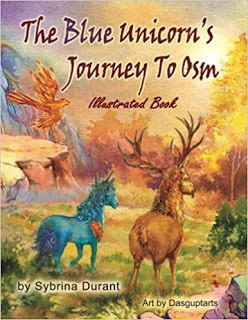 “The metal horned unicorns are doomed!” That’s what Lauda Lead Horn wailed when she first saw the tribe’s new savior. OK, so his horn was not metal. . .and he did not have a magic power. . .and he was really a puny little runt. But doomed? Were things really that bad?
“The metal horned unicorns are doomed!” That’s what Lauda Lead Horn wailed when she first saw the tribe’s new savior. OK, so his horn was not metal. . .and he did not have a magic power. . .and he was really a puny little runt. But doomed? Were things really that bad? Well, things were pretty bad in the land of MarBryn. Magh, an evil sorcerer utilized unicorn horns and hooves to create his magical potions and spells. Those he used, to increase his power and to conquer everyone in his path. All of the unicorns from the Tribe of the Metal Horn were now gone . . . except for twelve survivors.
Before the blue unicorn was born, Numen told Alumna, the aluminum-horned oracle, that he had a plan to bring the tribe back home to Unimaise. His prophecy was, “Only the blue unicorn can join with the Moon-Star. Until then, no new unicorns will be born.” Blue was the last unicorn born. Twenty years later, his horn was still covered with a plain blue colored hide. There was not a glint of metal to be seen on it or his hooves. And he still didn’t have any magic. But he was no longer scrawny and he had his wits. Though no one else in the tribe thought he had a chance, Blue felt ready to make Magh pay for his evil deeds. And he went off to do it alone. That was Blue’s first mistake. If the entire tribe was not standing horn-tip to horn-tip at the proper time and the exact place to help usher the Moon-Star Spirit into Blue’s horn, he would die. Then, the rest of the tribe would really be doomed.
Readers will follow along two journey paths in this book. Blue is joined in his travels by his mentor Gaiso, the Stag and his friend, Girasol the Firebird as they try to find their way across a danger-filled MarBryn to Muzika Woods. The rest of Blue’s tribe is forced to follow another route due to Nix Nickle Horn’s unfortunate incident with a Manticore. Nix, the great unicorn defender must safely lead the way for Ghel, the Golden-Horned unicorn; Silubhra Silver Horn; Cornum the Brass-Horned unicorn; Steel Horned Style; Cuprum the Copper-Horned unicorn; Tin-Horned Tinam; Dr. Zinko; Iown the Iron-Horned unicorn and the others in an action packed adventure to their destination in Muzika Woods. Both journey paths converge there in the Nebulium Circle.
Excerpt
The firebird hovered at the entrance of the canyon watching the three of them.
Blue was crunching on a rock. He giggled and said something that sounded like “silly bird” to the pendragon and they all laughed.
It was ridiculous. Girasol felt completely powerless and her feelings were hurt, too. She had no idea how she could help them.
“How can I make them listen to me?” she asked the mountains. Her normally bright orange flames had become a faint red glow.
"You can't," a voice which seemed to come from nowhere and everywhere at the same time answered. "I have induced hebephrenia into their feeble minds."
"Who are you and what is heb-phren-whatever you called it?" Girasol flared, melting some of the ice from the nearby rock faces.
"My, aren't you a hot-head?" the voice chuckled at her display of anger. "I am Yegwa. They call me the spirit of false springtime. I have put your friends and the pendragon under a spell which makes them think this is a wonderful place to live."
“Let them go," the firebird demanded, blue-white sparks spouting from her feathered crown. She could not see the spirit and was very frustrated.
"Let them go? I wouldn't dream of it. It’s not often I have this much fun," Yegwa said in a voice hungry with anticipation. "My magic doesn’t seem to work on you though,” she said thoughtfully. "It must be that hot blood of yours."
"What kind of spirit are you? How can you enjoy watching your victims freeze or starve to death?" Girasol asked. "You are so wicked. I don't know what's worse—you or that evil sorcerer, Magh," she shouted disgustedly. "Magh? Sorcerer? Do tell…he sounds like someone I would like,” Yegwa asked with interest. “Is he single?”
“Single? What?” Girasol blazed. “Forget about Magh! I don’t have time for this back and forth with you.”
“Ooh, well, la-ti-da…aren’t you the peppery dish,” Yegwa said, letting loose a shrill cackle. “If I had teeth, I’d eat you right up!”
"What about my friends?" the firebird asked again. She looked around the top of the canyon walls trying to find the owner of the ghostly voice.
"You're welcome to keep company with them if you wish. I don't keep anyone imprisoned, you know," Yegwa said, trying to sound sugary sweet.
“Thanks a lot,” Girasol said sarcastically. She tapped her head with her right wing, trying to figure out a way to save her friends. “Hot blood. . .hmmm. . .Warmth. . .that’s it,” she realized. “If they’re going to snap out of this, they need to be warm!” she thought suddenly.
They were going to freeze to death if she did not help them soon. She remembered seeing Blue pick up some pepo seeds earlier. She searched the bag hung across his shoulder and brought one out. He was so far gone, he did not even notice her. One seed would give her enough energy for five days. “In this cold, I might need this and more to keep them warm,” she thought, while chewing the seed.
LinksPurchase LinksEbook (plain illustrations)Ebook (Looks like printed book)Audio book (Listen to free sample)Hardcover SoftcoverBlack and White Print Book Coloring Book
Author LinksAmazon Author CentralYoutube (Book Trailers)FacebookGoogle+InstagramPinterestZazzleWebsite 1Website 2 ReviewsGoodreads
Twitter address @Sybrina_spt

document.write('');
Published on November 09, 2017 00:52
November 6, 2017
WHAT THE EXPERTS SAY: Sandra Nikolai, Mystery Author
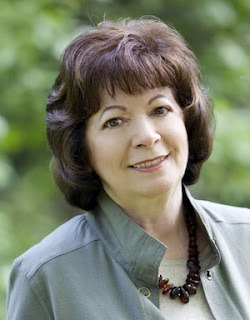 Sandra Nikolai, Author
Sandra Nikolai, AuthorBROKEN TRUST
Book 5 of Megan Scott/Michael Elliott SeriesSandra Nikolai just released BROKEN TRUST, the 5th mystery in her series featuring ghostwriter Megan Scott and investigative reporter Michael Elliott. Reviewers of previous books claim the series is “well-plotted and punctuated with shocks” and “impossible to stop reading.”
According to Nikolai, the pairing of protagonists helps “create tension and move the plot forward.” By setting this mystery in Ottawa, she takes advantage of the capital city’s healthcare decision-making, which supports the development of her plot.
Nikolai is currently working on Book 6 of her mystery series. When she’s not writing, she enjoys baking, especially anything with chocolate in it as she is a fan of desserts.
Q: What draws you to write Mysteries? Who is your favorite mystery author?
Sandra Nicolai: Puzzles have always intrigued me, and mysteries even more so. The ultimate test arrived the day I decided to write my first mystery novel. I’ve been published for five years now, but ensuring that all the pieces in a mystery fall into place is still quite the challenge. And I love every minute of it!
Some of my favorite mystery authors include Donna Leon, Linwood Barclay, Kathy Reichs, James Patterson, and Louise Penny. I also enjoy discovering new authors and regularly add their books to my to-read list. I don’t think I’ll ever catch up!
Q: In your new book, BROKEN TRUST, you’ve paired Megan Scott and Michael Elliott together again in your new book as double sleuths to solve the mystery. Does this pairing help to develop the plot? Romantic interest?
Sandra Nikolai: Yes to both questions!
In my latest book, BROKEN TRUST,as in the other books in the series, Megan and Michael’s characters differ in ways that help to create conflict in the story and move the plot forward. As an investigative reporter, Michael meets with seedy informants in dark alleys in his hunt for murder suspects. He thrives on taking risks. Megan’s participation in his sleuthing activities provides an exciting break from her “boring” job—ghostwriter of non-fiction material. Since she tends to be cautious and worries about Michael’s safety, their covert outings enable her to pull him back from the brink of death when necessary. Of course, Megan’s curiosity sometimes gets her in trouble too, so it works both ways.
The romantic interest between them originated in the first book, FALSE IMPRESSIONS, and continues to grow through the series. Is marriage a possibility? Michael might be inclined to the idea, but Megan’s bad experience with her first marriage planted doubts in her mind. The topic creates tension between them, which helps to develop the plot.
Q: How do you turn your ghostwriter into an amateur sleuth? What makes her credible?
Sandra Nikolai: FALSE IMPRESSIONS launched Megan’s investigative teamwork with Michael when they became prime suspects in the death of her husband and a female companion. That’s when Megan got her feet wet, so to speak. Her interest in Michael’s work prompted him to take her along on some of his ventures. They share a high standard of ethics that drives them to seek justice for crimes committed, but they have different approaches to analyzing the evidence.
When it comes to suspects, Michael is objective and trusts his instincts to guide him. Megan is an in-depth researcher and often deciphers the tiniest detail and nuance on the path to solving a crime. She bounces her theories off Michael and, although he doesn’t always agree with her, he appreciates her input. In the end, Megan’s contributions play a key role in resolving the crime.
Q: How useful is Ottawa as a setting to help develop your characters or the mystery? Would the story be different if set elsewhere?
Sandra Nikolai: Ottawa is Canada’s capital city and the setting for BROKEN TRUST, the fifth book in my mystery series. The city is home to the federal government where major political decisions affecting national health are made. My sleuths investigate the fentanyl crisis here. For readers unfamiliar with fentanyl, it’s a synthetic drug that’s fifty times stronger than heroin and the cause of thousands of deaths by overdose.
My sleuths are Canadian and have a special interest in how organizations are handling the drug crisis here. As they investigate the death of a young woman who supposedly overdosed in their Ottawa hotel room—yes, they walked in and found her body!—Megan and Michael interview key administrators regarding the fentanyl problem. A mystery set in a government town might sound dry to some readers, but I promise you, it’s a thrilling ride!
Q: Reviewers enjoy the suspense you’ve created in your previous mysteries. How do you create that page-turning drive?
Sandra Nikolai: Readers like to get to the heart of a story, so I keep the narrative as tight as possible. I cut back on excessive descriptions of people and places and avoid dialogue that doesn’t move the plot forward. I pepper my stories with clues (including red herrings), tension, and conflict.
My chapters are short and end with a cliffhanger. I ensure the momentum is fast-paced so that the action doesn’t stall. Readers tell me they can’t stop reading—they have to find out what happens in the next chapter. This tells me my techniques are working!
Q: What do you consider to be the key elements of a satisfying mystery?
Sandra Nikolai: The first pages should draw in the reader. Without a captivating hook, the reader will move on to another book. Setting a mysterious mood that foreshadows the journey ahead is also an important element.
Suspenseful dialogue between realistic characters is vital to retaining reader interest. It’s similar to eavesdropping on a heart-pounding conversation between people you know. My suspects often lie or withhold crucial information, but I keep readers in the loop so that they come across the clues at the same time as my sleuths do.
Wrapping up loose ends by the end of the story is another essential element. Readers need answers to confirm what they already know or didn’t know about who, why, what, and how. A satisfying resolution to a mystery means a reader will most likely read another book by the same writer.
Q: Why do readers care about your characters? How do they relate?
Sandra Nikolai: Like most people, my main characters have strengths and insecurities. Readers can relate to Megan’s determination and Michael’s courage as they track down perpetrators. They admire their mutual loyalty and respect and the way they interact with each other.
Readers root for Michael and understand his anger and frustration when he lacks the evidence to bring a cold-blooded killer to justice. They empathize with Megan’s lingering memories about her husband’s infidelity, as well as her qualms about Michael’s safety and the future of their relationship. They support Megan as she confronts dangerous situations, despite her fears.
Q: What are the attributes of an effective villain/criminal?
Sandra Nikolai: A credible villain is one that has good qualities and bad qualities. The criminals in my stories often work in typical jobs and have family or friends, yet they manage to get sidetracked by the darker side of life.
We’ve all seen news reports about police arrests of doctors, lawyers, and professors. Who would think that people in such respectable positions could be murderers? How many times do neighbors discover that the “man who lives down the street” is a killer? Criminals can’t be typecast. The creepiest part is that they often live among us.
Q: What’s next?
Sandra Nikolai: Book #6 in the series. My sleuths return home to Montreal where their greatest challenge awaits them. It will be a roller coaster of a thriller. Oh, I can’t wait to write this one!
Q: Tell us about Sandra Nikolai. What do you like to do when you’re not writing?
Sandra Nikolai: I love desserts, so I’ll bake anything with chocolate in it. No surprise there, right? I also like to read, shop, watch movies, go for walks, and catch up with friends over coffee. My routine might sound dull to some people, but the first half of my life was quite hectic, so I welcome the change. I wouldn’t be able to write without the peace and quiet I now enjoy.
Thank you for inviting me, Joyce!
About Sandra Nicolai
Author Sandra Nikolai weaves ordinary characters into extraordinary, life-threatening situations, using the premise that evil often lurks in familiar places. She is the author of a mystery series featuring ghostwriter Megan Scott and investigative reporter Michael Elliott. BROKEN TRUST is the fifth book in this series.
Sandra has also published more than a dozen short stories online and in print, garnering Honorable Mentions along the way. She shares her writing experiences on her blog and has been a frequent guest writer on other blogs.
About BROKEN TRUST
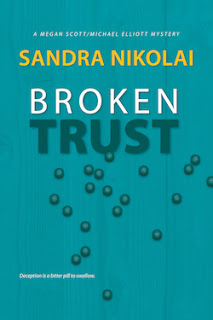 Hotel rooms often come with perks. A corpse isn’t one of them.
Hotel rooms often come with perks. A corpse isn’t one of them.Ghostwriter Megan Scott and investigative reporter Michael Elliott discover the body of a young woman in their Ottawa hotel room. Not what they expected on a business trip to Canada’s capital. She’s wearing a black lace teddy. A carafe of red wine and two glasses sit on a table. A closer look inside her purse reveals thousands of dollars, three business cards, and a supply of pills.
The detective initially writes off Becca Landry’s death as an open-and-shut case of overdose, but Frank Landry, an ex-military, believes his wife was murdered. Convinced that autopsy results will prove him right, he fears the police will soon target him as a prime suspect. He asks Megan and Michael to investigate.
As they dig deeper, they unearth shocking links that expose the dark underbelly of a city where widespread fraud, illegal drug trafficking, and a sense of entitlement defy the system. Elusive conspirators up the stakes and threaten to block their efforts at any cost.
How can Megan and Michael ensure their trust in each other is enough to save them on a perilous quest for a cold-blooded killer?
Links
Amazon Author siteAmazon KindleAmazon Paperback
All bookstores
Website
Twitter: @SandraNikolai
Published on November 06, 2017 00:06
October 20, 2017
WHAT THE EXPERTS SAY: Leonora Meriel, Author
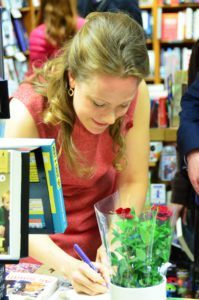 Leonora Meriel, Author
Leonora Meriel, AuthorTHE WOMAN BEHIND THE WATERFALL
THE UNITY GAMEWhen Leonora Meriel starts to write a novel, she is never sure which genre will “rise most strongly to the surface.” Whether she is bringing us the “magical realism” of her first novel THE WOMAN BEHIND THE WATERFALL, or the expanded realm of science fiction in her most recent novel, THE UNITY GAME, she writes to the perfection of literary fiction. She creates characters who have flaws preferring the grey-tones of real life to the black and white of heroes versus villains. Her extensive travels have given her insight and the ability to stay open to the uniqueness offered by other cultures and lifestyles.
Meriel shares her home between London and Barcelona, and enjoys exploring the worlds offered by travel as well as the world surrounding her two “interesting” children. She finds that running helps to clear her mind. She is currently working on a new literary fiction novel.
Q: Your novels cross genres. When telling your stories, do you consider what is the most appropriate genre? Are some themes better told in specific genres? Is science fiction more supportive of telling some stories and literary fiction others?
Leonora Meriel: When I set out to write a book, I usually have a myriad of ideas, but I am never certain which ones are going to develop into the main story line. It takes a few weeks of following different paths before I understand which central idea lies the deepest in me and demands to be explored through the 3 – 5 years it takes to perfect an entire novel. In the same way, those myriad ideas may each fall into different genres, and so when I start a novel, I never know exactly which genre will take precedence or which idea will rise most strongly to the surface.
I enjoy mixing combinations of genres, however I see all of the genre elements I use as existing beneath the umbrella of literary fiction, which will always be my primary genre. My understanding of literary fiction is where the quality and artistic value of the writing comes first, and the plot, characters and everything else comes second. In pure genre fiction, this is often the other way round.
Q: THE WOMAN BEHIND THE WATERFALL has been described as “magical realism”—an interesting and appealing concept. How do you define magical realism? And how does THE WOMAN BEHIND THE WATERFALL meet that definition?
Leonora Meriel: I define magical realism as a story that is at least 70% set in the accepted world and society of humankind. The other 30% may be supernatural elements, usually associated with the spirit world. In magical realism, the magic is not at the center of the story, but it enhances the story. One could contrast this with zombie or wizard genre fiction, where the supernatural elements are the very core of the story. In magical realism, they are a feature that support a central story told in the real world.
In THE WOMAN BEHIND THE WATERFALL, the main characters are a mother and a daughter living in a village in western Ukraine. Their life is simple and very rooted in everyday domestic tasks – fetching water from the well, making a cake of honey and walnuts. The mother drinks vodka and struggles with depression. Around this story, the spirit of the grandmother returns to a nearby riverbank to help the mother overcome her unhappiness, and the daughter finds she can merge into the spirit of nature around her. Thus, the central story is the search for happiness, but the magical realism elements serve to illustrate and enhance aspects of that journey.
Q: One reviewer describes THE UNITY GAME as “sci-fi with a bit more of a deeper meaning” and “deeply philosophical science fiction.” Others applaud “love of characters” & “creative plot.” How did you conceive of the plot? Are you a SciFi fan?
Leonora Meriel: I love any writing that is brilliant, irrespective of genre, and some of the best literature ever written is science fiction. A few of the books that have deeply influenced me are Stanislaw Lem’s SOLARIS, Ursula Le Guin’s THE LEFT HAND OF DARKNESS and more recently Ken Liu’s THE PAPER MENAGERIE. These are some of the finest pieces of fiction ever written and the fact that they take place in different worlds and dimensions makes them even more powerful and transformative.
One of the key elements of great sci-fi is that it is always deeply philosophical. Life on another planet will always cause us to consider life on our own planet, and one of the key tasks of sci-fi is to question, to provoke questions, to envision futures. It is perhaps the most challenging of all genres, as it demands a relation to the current world and a relation to the possible, in the way that fantasy (zombies and wizards) does not. When I started writing THE UNITY GAME I had burning questions about the meaning of everything, and I found that those questions did not fit into an Earth-based plot. Sci-Fi enabled me to go as wide and deep and philosophical as I desired in order to explore possible answers to those questions.
Q: You travel extensively and have lived in multiple countries with different cultures. How does travel influence your writing, your characters, and your plots?
Leonora Meriel: I believe that travel is essential for a writer. Ideally, not only visiting, but living in different cultures, and allowing those cultures to change you and permanently open something new in your character and your soul. As children, we are all immersed in the culture and thought-systems that we grow up with, and the older we get, the harder it becomes to stop imbedded beliefs from stagnating permanently inside you.
I believe that part of a writer’s job is to battle against residual thought-patterns and to strive to stay open to other ways of thinking and other cultures and other perspectives. The writers and artists must be the ones in society who envision new thought and futures and possibilities and cultures and societies. But this new thinking will not come from dusty, inherited knowledge. Travel and new cultures are essential to keeping minds and hearts open and receptive and curious.
Q: Reviewers claim that THE WOMAN BEHIND THE WATERFALL is “thought-provoking.” Did you intend for the novel to deliver a message and make readers think? Or did you write it primarily to entertain?
Leonora Meriel: THE WOMAN BEHIND THE WATERFALL was my debut novel and my main goal was to write the best possible book that I could. I had many ideas I wanted to write about but there wasn’t a central message that I planned to convey. However I did have one specific goal within the book, which was to portray the culture and land of Ukraine, and allow readers in the west to experience a country where I had lived for many years, and which was wildly beautiful. I am delighted that reviewers have called it “thought-provoking” as that suggests that some of the ideas that run through the novel have resonated with readers.
Q: How do your characters engage the reader? Why will readers care what happens to them? Are they super-heroes or ordinary people in extraordinary situations?
Leonora Meriel: My characters are all ordinary people, and they all have a balance of strong points and flaws. In my debut novel THE WOMAN BEHIND THE WATERFALL, Lyuda believes she has got everything in her life wrong and can’t bring herself to embrace happiness. It is her seven-year old daughter, Angela, who forces her to confront her issues and make a choice, but not without herself experiencing some of the pain of the adult world.
In my second novel THE UNITY GAME, the hero is a New York banker who is sucked into the addictive world of money and success and ego, but finds he is unable to cope.
I try to make the characters I write extremely realistic, so that even if the readers could not imagine themselves in that position, then they clearly understand how the characters are in that position and why they are taking the actions they choose. I truly believe that once we can see through the eyes of another human being, then we will empathize with them automatically, and this is one of the great tools open to writers – to draw readers into worlds that they wouldn’t normally have access to – and to open their minds and hearts just a little wider.
Q: THE WOMAN BEHIND THE WATERFALL is set in Ukraine and one reviewer says that the reader will “experience the authenticity of Ukrainian village life.” In addition, does the story have a universal theme relevant to a spectrum of readers?
Leonora Meriel: Yes, it certainly does. The universal theme is – the search for happiness. Lyuda, the main character, fights against depression every day. She has made mistakes in her life, and she allows herself to live in the past, as I think many people in the world do today. Her daughter, Angela, lives very much in the moment-to-moment joy of everyday life – seeing the changing nature and seasons around her, and the tiny details of the world as filled with happiness. Slowly, she teaches her mother to live in the present and leave the dark past behind. In this strange world we live in, I think that ‘what it means to be happy’ and ‘how to be happy’ are big questions that we all ask ourselves. In THE WOMAN BEHIND THE WATERFALL I explore this from several points of view and I intended it to be relevant to a wide spectrum of readers.
Q: Does the concept of “heroes vs villains” apply to your story-telling? If so, can you describe the characteristics of an effective villain? Can culture, mores, philosophies, religion, or family traditions be considered villains?
Leonora Meriel: I don’t use the concept of “heroes” or “villains” in my novels, as this is a simplistic view of people that fits better with genre fiction or with children’s books. I am far more interested in shades of good and bad, and how individuals struggle with the challenges of moving in directions that are more or less harmful to them. Culture, mores, philosophies, religion, and family traditions can certainly be used as villains within a story, but in this “villainous” role they would act simultaneously as catalysts to provoke the characters to certain actions. For example, in my most recent Sci-Fi novel THE UNITY GAME, the alien character is emboldened to reject its home planet and its philosophy once it has realized that there is no true free will there.
Q: What’s next?
Leonora Meriel: A new literary fiction novel. My aim is to write a novel without using any other genres – a straightforward tale with some great quality writing. However, neither of my novels so far has turned out to be how I envisioned them at the beginning, so you’ll have to wait and see!
Q: Tell us about Leonora Meriel. What do you like to do when you’re not writing?
Leonora Meriel: Exploring is the main thing I do – which is really research as a writer. I love to explore countries, cities, ways of life, new people, different personalities, roles and also new worlds in books. I am the mother of two incredibly interesting children, and I try to understand their world as it forms around them. Apart from exploring, I love to run, which clears out all the thoughts that have entirely filled my head. And visit the city of Barcelona as much as possible, where there is so much creativity on every street corner, and sunshine and laughter and sea.
About Leonora Meriel
Leonora Meriel grew up in London and studied literature at the University of Edinburgh in Scotland and Queen's University in Canada. She worked at the United Nations in New York, and then for a multinational law firm.
In 2003 she moved from New York to Kyiv, where she founded and managed Ukraine’s largest Internet company. She studied at Kyiv Mohyla Business School and earned an MBA, which included a study trip around China and Taiwan, and climbing to the top of Hoverla, Ukraine’s highest peak and part of the Carpathian Mountains. She also served as President of the International Women’s Club of Kyiv, a major local charity.
During her years in Ukraine, she learned to speak Ukrainian and Russian, witnessed two revolutions and got to know an extraordinary country at a key period of its development.
In 2008, she decided to return to her dream of being a writer, and to dedicate her career to literature. In 2011, she completed THE WOMAN BEHIND THE WATERFALL, set in a village in western Ukraine. While her first novel was with a London agent, Leonora completed her second novel THE UNITY GAME, set in New York City and on a distant planet.
Leonora currently lives in Barcelona and London and has two children. She is working on her third novel.
 About THE WOMAN BEHIND THE WATERFALL
About THE WOMAN BEHIND THE WATERFALLHeartbreak and transformation in the beauty of a Ukrainian village.
For seven-year old Angela, happiness is exploring the lush countryside around her home in western Ukraine. Her wild imagination takes her into birds and flowers, and into the waters of the river.
All that changes when, one morning, she sees her mother crying. As she tries to find out why, she is drawn on an extraordinary journey into the secrets of her family, and her mother's fateful choices.
Can Angela lead her mother back to happiness before her innocence is destroyed by the shadows of a dark past?
Beautiful, poetic and richly sensory, this is a tale that will haunt and lift its readers.
 About THE UNITY GAME
About THE UNITY GAMEWhat if the earth you knew was just the beginning?
A New York banker is descending into madness.
A being from an advanced civilization is racing to stay alive.
A dead man must unlock the secrets of an unknown dimension to save his loved ones.
From the visions of Socrates in ancient Athens, to the birth of free will aboard a spaceship headed to Earth, The Unity Game tells a story of hope and redemption in a universe more ingenious and surprising than you ever thought possible.
Metaphysical thriller and interstellar mystery, this is a 'complex, ambitious and thought-provoking novel' from an exciting and original new voice in fiction.
LinksPurchase LinksTHE WOMAN BEHIND THE WATERFALLAmazonBarnes and Noble
THE UNITY GAMEAmazonBarnes and Noble
Author Links
Goodreads Website Facebook Twitter
Published on October 20, 2017 00:32
October 18, 2017
CHECK IT OUT: Character Interview by Joyce T. Strand, Author
 Joyce T Strand, Author
Joyce T Strand, AuthorDangerous Changes
Coming November 8, 2017Following is an interview with my newest character sleuth, Emily Lazzaro, who is here to introduce the cover of her first mystery, Dangerous Changes, and let us know that the book will be released on Wednesday, November 8, 2017.
Fans of my other books might recall that Emily is the daughter of the winemaker at Brynn Bancroft’s Hilltop Sunset winery. When we last encountered her in OVERCAST SUNSET, she had just broken up with her fiancé and is heading back home to Ramona, Calif.
Q: Hey, Emily Lazzaro. What do you think about being the newest Joyce T. Strand sleuth in your first mystery, Dangerous Changes?
Emily Lazzaro: I’m not so sure about it.
Q: Why? What’s happening?
Emily Lazzaro:First, I broke up with my fiancé. Then I had a frightening experience on the way home one night from a meeting where a pickup truck deliberately tried to run me off a curvy mountain road. It was quite scary. Then the brother of the man who tried to run me off the road…but I can’t go into that. Anyway I just can’t seem to make the changes that will get me to where I want to go. Whenever I try, something dangerous happens to me—there’s even been a murder. Can you believe it?
Q: What changes do you want to make?
Emily Lazzaro: At the moment, to make a living, I’m preparing taxes for people to make a living but I’d sure like to make some changes to do something else. And my ex-finance keeps after me—like he wants us to get back together. We’re still friends, and I help him with his new business, but I’d like to look for a different relationship, and I’m not at all interested in his new business. However, his vineyard that he purchased just doesn’t provide him with enough money to make ends meet.
Q: So what made you decide to stay in the same town where your ex-fiancé lives?
Emily Lazzaro: I really like the rural community of Ramona. That’s another change I’d like to make. I want to live here permanently. I love the unique rocky terrain and proximity to the ocean and San Diego, along with the mixture of fine wineries, artists, and equestrian focus. I want to live here and make my life here. But I need to find a different career than that of tax preparer.
Q: Thank you so much for this interview. I can hardly wait for your first book which will be released Wednesday, November 8, 2017.
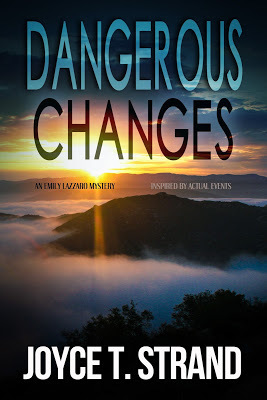
About DANGEROUS CHANGES
A series of events rattle Emily Lazzaro: a near-death encounter with a pickup on a narrow mountain road, the murder of a would-be client, and an ex-fiancé who won’t let go. Can she survive a police investigation, pressure from her ex’s company, and the suspicions of a possible new love-interest—so that she can make the changes to create a meaningful new life in a special town in southern California?
About Joyce T. Strand, Author
Joyce T. Strand is the author of who-done-it contemporary and historical mysteries set in California. Actual events and/or real people inspired all of her published novels, although they are definitely fictionalized. Dangerous Changes is her ninth book.
Strand headed corporate communications at several biotech and high-tech companies in California's Silicon Valley for more than 25 years. Unlike her protagonist Jillian Hillcrest, however, she did not encounter murder in her career. She currently lives with her collection of cow statuary in Ramona, California, and enjoys exploring and writing about the growing wine region in the Ramona Valley near San Diego.
LinksAmazon author pageBarnes and NobleWebsite Goodreads Facebook Twitter: @joycetstrand
Published on October 18, 2017 00:14
October 13, 2017
CHECK IT OUT: New Release, SECRETS HIDDEN IN THE GLASS by Cate Beauman
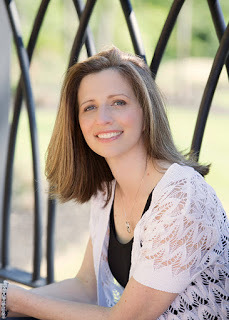 Cate Beauman, Author
Cate Beauman, AuthorSECRETS HIDDEN IN THE GLASS
and
The Bodyguards of L.A. County seriesCate Beauman just released her twelfth novel, SECRETS HIDDEN IN THE GLASS. The author of the best-selling Bodyguards of L.A. County series is introducing her first non-Bodyguard romantic mystery set in Sanderson, Massachusetts, the fictitious, tiny town on the equally made-up Carter Island.
Her multi
In the following brief article, she explains the inspiration behind her newest novel.
Don't miss the excerpt and the opportunity to enter the chance to win one of five $10 Amazon gift cards at the end of the interview.
The Inspiration Behind SECRETS HIDDEN IN THE GLASSBy Cate Beauman
I always find the process of writing fascinating—imagining words and thoughts into subsistence that had once only existed in my head. Oftentimes, the undertaking is daunting. Months of research, careful plotting, planning, character development, and revising go into every page. There are many moments of doubt and worry. On occasion, there’s even a triumph or two. But finally, you type The End and you realize you’ve created a miracle of sorts—a story to share with your eager readers who are always waiting for what’s next.
I had such fun telling Nate and Callie’s adventure. There was something extra enjoyable about bringing Sanderson, Massachusetts to life—the fictitious, tiny town on the equally made-up Carter Island. Imagine dreaming up a beachy setting that gets to be exactly what you want it to be. Add a group of intriguing (and on occasion quirky) characters. Throw plenty of steamy romance and several sprinkles of mystery and suspense into the mix and you’ve got yourself one heck of a good time.
About Cate Beauman
International bestselling author Cate Beauman is known for her full-length, action-packed romantic suspense series, The Bodyguards of L.A. County. Her novels have been nominated for the National Excellence in Romance Fiction Award, National Indie Excellence Award, Golden Quill Award, Writers Touch Award, Aspen Gold Award, Heart of Excellence Award, and have been named Readers Favorite Five Star books.
In 2017 FINDING LYLA was chosen as the Booksellers Best Award Winner, the Maggie Award For Excellence, and received the Holt Medallion Award. REAGAN'S REDEMPTION and ANSWERS FOR JULIE were selected as rare co-winners of the Aspen Gold Award in 2016. JUSTICE FOR ABBY received the 2015 Readers' Favorite International Book Award Gold Medal, while SAVING SOPHIE took the Silver Medal. SAVING SOPHIE was also selected as the 2015 Readers Crown Award winner for Romantic Suspense and FALLING FOR SARAH received the silver medal for the 2014 Readers' Favorite Awards.
Cate makes her home in North Carolina with her husband, two boys, and their St. Bernards, Bear and Jack.
About SECRETS HIDDEN IN THE GLASS
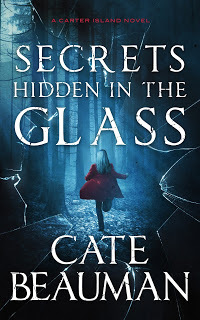 Stained glass artist Callie Davis is in desperate need of a vacation. Burnt out and on the edge of a nervous breakdown, she’s fleeing the pressures of her career and is taking refuge on Massachusetts’ tiny Carter Island. Callie yearns for long, lazy days and pretty walks on the beach—blessed solitude and an escape from the complications of her life. Then she bumps into gorgeous Nate Carter and everything changes.
Stained glass artist Callie Davis is in desperate need of a vacation. Burnt out and on the edge of a nervous breakdown, she’s fleeing the pressures of her career and is taking refuge on Massachusetts’ tiny Carter Island. Callie yearns for long, lazy days and pretty walks on the beach—blessed solitude and an escape from the complications of her life. Then she bumps into gorgeous Nate Carter and everything changes.Sheriff Nathan Carter couldn’t be happier now that the height of the summer season has finally come and gone. After four endless months, tourists have packed their bags and headed for the mainland. The quiet days of autumn are about to befall the town—the way Nate and his fellow Sandersonians like it best.
But nothing ends up quite the way Nate expects when he meets the beautiful blonde with the big blue eyes. Callie’s pretty smiles hide secrets—deep, dark mysteries that could cost them both their lives if they continue digging into the past and cross a killer’s path.
Excerpt from SECRETS HIDDEN IN THE GLASS
Callie held her head up to the brisk winds blowing off the Atlantic as the ferry brought her closer to the island. She breathed in the salty air, letting the gusty slaps of cold sting her cheeks while the boat cut through the waters the clouds had cast a dismal gray. At two thirty this morning she’d dreamt of sunshine and whale sightings on her travels north toward the Hyannis Port docks, but choppy seas and intermittent raindrops were better than spending one more minute in New York.
She shuddered as she thought of the city and glanced over her shoulder, constantly on guard against the sense of unease she hadn’t been able to shake for months—the need to run. Three weeks away in Europe promoting her latest work was supposed to have helped. When that didn’t go as planned, she’d been certain the four-week gallery tour she’d been contracted to attend would have fixed everything, but nothing seemed to shake the restless, edgy energy that kept her up most nights.
Facing forward again, she stared down at her white-knuckled grip on the bold blue railing and commanded herself to relax, even as her heartbeat began thrumming a frantic rhythm. She clutched the cool metal tighter and closed her eyes, bracing for anxiety’s cruel surges of adrenaline that often left her a pathetic, trembling mess. “Everything’s all right,” she reassured herself, then let her head hang as she heard the lack of conviction in her own voice, certain she was teetering on the perilous edge of a nervous breakdown. For surely that’s what this had to be. She was officially cracking—caving to the never-ending demands of her career and her sudden inability to create.
“Folks, take a moment and look straight ahead,” the boat’s captain boomed through the speakers, startling Callie out of her thoughts. “You’ll see Point West Lighthouse coming into view.”
Callie opened her eyes and blinked, staring at the bright beam of light far in the gloomy distance.
“Point West Lighthouse has been a beacon of hope, welcoming sailors home to Carter Island for nearly four hundred years,” the captain continued in his strong Massachusetts accent.
Callie wiped her cheeks, finding comfort in the idea as she studied the black-and-white stripes of the mighty island tower. What must it have been like to battle raging storms and contend with months of endless seas, then finally see the light? To have weathered the worst of it all and found hope waiting on the other side? She longed to have an answer—and perhaps someday she would. According to Captain Bob, the boat was due to dock in fifteen minutes and her vacation would officially begin. She needed quiet—a few weeks to pull herself together. Then maybe she could start to figure out when it was that her life had started falling apart.
Links
Purchase Links
Kindle USKindle CAKindle UKKindle AUKoboiBooks
Nook
Author LinksAmazon Author PageBookBubGoodreadsTwitter: @CateBeaumanwebpage
FacebookInstagram
Rafflecopter Page Link Click here to enter chance to win one of five $10 Amazon gift card.https://widget-prime.rafflecopter.com...
Published on October 13, 2017 03:49
October 3, 2017
WHAT THE EXPERTS SAY: Saiswaroopa Iyer, Author
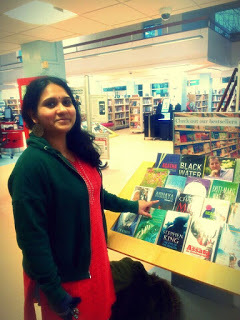 Saiswaroopa Iyer, Author
Saiswaroopa Iyer, AuthorAVISHI
ABHAYASaiswaroopa Iyer’s novel, AVISHI has been described by reviewers as “Great fiction set in early days of Indian civilization” and “an out and out thriller” that is “gripping.” She writes her novels to remind us of our past and claims that “My characters drive me to write.” Although a novel set in the past, she researched the setting to assure accuracy from a “civilizational aspect.” She also believes the themes and story are universal even though set in India.
Formerly an analyst at a venture capital firm, Iyer today lives in London where she enjoys writing her novels. She enjoys traveling, especially to locations that are of historical interest. She is currently writing a sequel to her first novel, ABHAYA.
Q: What inspired you to write about and re-imagine Vishpala of the Rig Ved in your book AVISHI?
Saiswaroopa Iyer: I stumbled upon Vishpala, mentioned in the Rig Veda when I was searching for ancient women warriors of India. According to Rig Veda, Vishpala loses her leg in a nocturnal battle and is granted a metal leg by Ashvinas, the divine physicians. The hymn mentioning her is also the very first reference to prosthesis in world literature. A bit more of reading about the Rig Vedic society revealed a very Q: How do you make your characters credible? Why will your readers care about what happens to them?
Saiswaroopa Iyer: My characters drive me to write. They are driven by their goals which compels me to write about them, draw inspiration from them, seek answers from them and take up the challenges they pose me. I think this is the combination that makes them stay alive through the writing process and write their own story. I strongly believe that lively characters have their own way of making the readers root for them, hate them, love them and form that kinship with them as they progress through the book.
Q: How important was historical accuracy and setting to tell your story?
Saiswaroopa Iyer: Setting of the story requires a lot of accuracy from civilizational aspect. The tools, lifestyle, social constructs, etc matter a lot in the process of world creation. That does not mean that we don’t have creative liberty. But honest research into facts will also help in channelizing and deploying creative liberty effectively. For eg, I was able to imagine an ancient society where marital constructs were not yet defined only after an examination of evolution of wedlock as an institution.
Q: Although your book is set in India, do you believe that the message and story are universal?
Saiswaroopa Iyer: Every message of Rig Veda (and the rest of Vedas too) is universal. I love India. But the very charm of India starting right from the dawn of civilization has been that the Indic thought keeps universal wellness ahead. While the civilizational aspects might seem intriguing to a western reader, I believe there is something for everyone to connect.
Q: Does the concept of hero versus villain apply to AVISHI? What are the characteristics of an effective villain?Saiswaroopa Iyer: An interesting question. I believe any story that seeks to grip the reader attention needs these two poles. What makes a hero and what makes a villain (and what makes the rest)? I believe it is the series of choices one makes through the course of their journey and how they face conflicts, deal with the intrigues of fate, make tough choices.
Q: Did you write AVISHI strictly to entertain or did you embed some key messages or themes to deliver to your readers?
Saiswaroopa Iyer: I wrote Avishi to mainly invoke the civilizational past, which I hope will help us in remembering the civilizational past and connecting to our strong willed ancestors. As for delivering messages, I leave it to my characters and my readers to gather their own meanings J
Q: One reviewer calls your book “gripping.” How do you create suspense to cause your readers to want to turn the pages?
Saiswaroopa Iyer: Thank you for going through the reviews! Pace and tautness is something that we writers learn in our own journey of writing. It comes from practice and self-critiquing asking ourselves every now and then, “does this sentence/paragraph/page prod the reader to go to the next?” or “Does this leave the reader with sufficient intrigue to get back?” I admit it is not easy. But doable and exciting!
Q: What caused you to switch careers from investment analyst to writing?
Saiswaroopa Iyer: Writing (Storytelling to be specific) was something I always had in mind. For many years my day job did not leave me enough bandwidth to pursue it full time. But my move to London a couple of years back made it amenable to me to pursue writing and also learn about publishing industry.
Q: What’s next?
Saiswaroopa Iyer: I am writing the sequel to my first novel ABHAYA, temporarily titled as Daughter of Mura. It is the story of a young girl who briefly appears in Abhaya but will have adventures of her own in the upcoming book. It would be a standalone novella but set in the ‘Abhaya universe’.
Q: Tell us about Saiswaroopa Iyer. What do you like to do when you’re not writing?
Saiswaroopa Iyer: Read and listen to lecture series on topics of my interest. I love travelling and visiting places of historical importance. I love to spend quality time with my family.
About Saiswaroopa Iyer
Formerly an analyst with a Venture capital firm, Saiswaroopa's interests include Startups, Economics, Carnatic Music, Philosophy, Politics, History and Literature of India. She won a state level gold medal from TTD in rendering Annamacharya Kritis. She holds an MBA from Indian Institute of Technology Kharagpur.
About AVISHILong before the times of Draupadi and Sita
Immortalised in the hymns of Rig Veda
But forgotten to the memory of India
The Warrior Queen with an iron leg, Vishpala
Brought up in the pristine forest school of Naimisha, Avishi reaches the republic of Ashtagani in
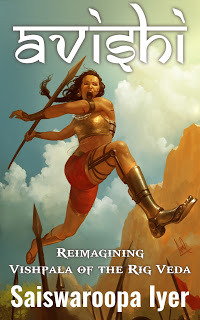 search of her destiny. When Khela, the oppressive King of the neighbouring Vrishabhavati begins to overwhelm and invade Ashtagani, Avishi rises to protect her settlement, but at a high cost.
search of her destiny. When Khela, the oppressive King of the neighbouring Vrishabhavati begins to overwhelm and invade Ashtagani, Avishi rises to protect her settlement, but at a high cost.Separated from her love, her settlement broken, with a brutal injury needing amputation of her leg, can Avishi overcome Khela?
If stories about ancient India, especially those with strong women characters interest you, then Avishi is a story you must read!
Links
AmazonWebsite FacebookGoodreads Newsletter
Twitter address - @Sai_swaroopa
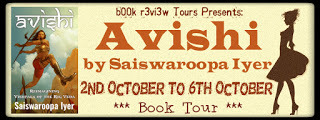
document.write('');
Published on October 03, 2017 00:07
September 21, 2017
WHAT THE EXPERTS SAY: James P. Wilcox, Author
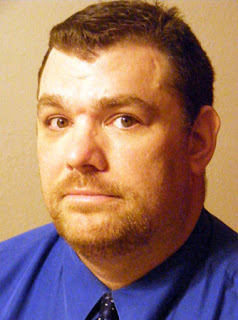 James P. Wilcox, Author
James P. Wilcox, AuthorA FALL FROM GRACEJames P. Wilcox just released his thriller A FALL FROM GRACE about a terrorist attack against the American Catholic Church. In the belief that plausibility is a key attribute of suspense, he creates characters that are neither all bad nor all good. Wilson believes that his background as a photographer helped him to visualize a scene and as a reporter to describe it.
Today Wilcox is a high school social studies teacher—an activity he also believes helps him to envision his story in a way to tell to his readers. He has written two other novels— SEX, LIES, AND THE CLASSROOM and THE M-16 AGENDA in addition to the International Bestseller MIRACLE CHILD. He is currently working on his fourth novel, and lives in Kansas City with his wife and three children.
Q: What led you to think of A FALL FROM GRACE?
James P. Wilcox: I have been toying around with the idea for A FALL FROM GRACE for several years now. Honestly, I got the original idea on a Sunday morning, day-dreaming at church. I was thinking about what would happen if there was a terrorist attack on my church, during mass. I then started thinking about what kind of person would stand up to the terrorists. David, the main character of A FALL FROM GRACE, was born in my mind that day.
Q: Your books cross genres and include poetry, thrillers, and non-fiction. Do you have a favorite? Do you believe that different writing approaches can help “tell your story” more readily? That is, can you express some stories better in poetry and others with fiction and/or non-fiction?
James P. Wilcox: I know I should probably care about genres and what genre my work falls in, but I really don’t care about genres very much. I just enjoy trying to tell a good story and I enjoy writing. Although I published a poetry collection, I wrote most of the poems during high school and college, as that was the writing format that worked the best for me at the time. I did include some recent poems, but poetry simply is not my primary writing format anymore. Anyone who has read any of my novels knows that they are hard to put in any particular genre. They are all hybrids, which is one of the reasons I like them so much.
Q: Reviewers of a previous fiction book highlight your “strong characters.” How do you engage readers to care about your characters? What makes them strong?
James P. Wilcox: I try to make my characters as realistic as possible and I try to make them well-rounded “humans.” I try to show both the good and the not so good qualities of each character, regardless of whether they are considered the hero or the villain. I also try to show the motivation of each character. I don’t write a character as good or as evil simply for the sake of making them good or evil. I try to show what makes the good or evil and the motivation behind the actions. I spend a lot of time thinking about and getting to know my characters, which is one of the reasons it takes me a long time to write each one of my books.
Q: How supportive is setting to tell your story A FALL FROM GRACE? Could it be told in any time period or in any city?
James P. Wilcox: The setting certainly frames the story of A FALL FROM GRACE and it is clearly set in our present day world. Ultimately though, A FALL FROM GRACE is a timeless story of good versus evil and the lengths people will go to in order to reach their goals. The story could hold up, with some adjustment, if it was set in the past or in the future.
Q: Are you able to use your background as a reporter, news photographer, or teacher to tell your stories? Does your background influence your writing?
James P. Wilcox: I learned how to write as a newspaper reporter and I learned how to think visually as a photographer. Both of these skills are critical to the writing process, at least for me. I usually “see” the scene as a picture in my mind before I actually start writing. Once I have the picture in my head, it is then simply a matter of describing, in as much detail as possible, what I already see. As a History teacher, I am telling stories each and every day, but with time restrictions. Teaching helps me pick out the important information, and I get to practice telling the story of American history in language that everyone can understand. I definitely think my background in teaching and journalism have made me a better writer.
Q: What do you believe are the key attributes of a thriller? How do you develop suspense in A FALL FROM GRACE to keep readers turning the page?
James P. Wilcox: I think the key attribute of a thriller is that it needs to be plausible. The readers have to believe that the story could actually happen in the “real” world and the characters have to behave like “real” people. If I put my characters in completely unbelievable situations, or that react in unbelievable ways to the situations they find themselves in, then I lose the readers. What I strive to do is create characters the reader can relate to, and hopefully care about, then put them in realistic situations, and then let the suspense build around them.
Q: Does the concept of “hero versus villain” apply to A FALL FROM GRACE? What are the characteristics of an effective villain?
James P. Wilcox: There are certainly characters in A FALL FROM GRACE who can be considered heroes and some who can be considered villains but I try to spend as much time developing my villains as I do my heroes. I actually want readers to make a connection to my villain, as well as my heroes. An effective villain is simply a well-written hero who made some “bad” decisions, although they may think what they are doing is right. I try to make my heroes and villains a difference in perspective because real life is rarely black and white. The world is full of shades of grey and writing about the gray makes both the heroes and villains believable.
Q: Do you write to deliver a message? Or do you write only to entertain your readers?
James P. Wilcox: That really depends on what I am writing. Obviously when I was writing Miracle Child, which tells the story of what happened when my son Nathaniel was born sixteen weeks early, I was hoping to convey hope to every parent, to every family who is faced with a situation similar to ours. I was also hoping to show the power of faith, of hope, of love, and of family.
When I write fiction, my number one goal is to entertain the readers. Having grown up as an avid reader, I just love reading a good story and I hope I can provide readers with good stories that reflect the world we live in today. I am not shy about what I write about though. Whether it be race relations, terrorism, or politics, I do hope that my stories will make my readers ask questions about uncomfortable topics and become more informed. Ultimately, whether I write poetry, fiction, or non-fiction, I hope the readers enjoy reading my work as much as I enjoy writing them.
Q: I know you’ve just finished A FALL FROM GRACE, but what’s next?
I am already working on a follow-up to my debut novel Sex, Lies, and the Classroom tentatively titled Sacrificing Tyresha. I have also started a family drama titled Wrestling Louise Braille. On top of that, I have an idea for a dystopian novel tentatively titled Saving Christ. Of course, I really don’t think I am finished with David, Alanna, and O’Malley and hope to continue their story in a follow up to A FALL FROM GRACE. I don’t have a working title yet, but hope to have one soon.
Q: Tell us about James P. Wilcox. What do you like to do when you’re not writing?
Not much to tell really. I am a busy husband and dad, who teaches high school Social Studies during the day and tries to get some writing done at night between all of the soccer, volleyball, basketball, cross country, and softball practices, games and meets, Scout meetings, and errand running that are required each day. In what little free time I have, I enjoy watching (or listening) to Kansas City Royals baseball, taking pictures, and reading books.
About James P. Wilcox
James Wilcox, a former newspaper photographer and writer, is currently a high school social studies teacher in Kansas City, where he lives with his wife and three children. James is also the author of novels SEX, LIES, AND THE CLASSROOM and THE M-16 AGENDA , A FALL FROM GRACE, as well as a work of poetry title Musings of a Particular Bear: A Poetry Collection. He is also the author of the #1 International Bestseller MIRACLE CHILD . James is currently working on his fourth novel.
ABOUT A FALL FROM GRACEDavid never intended to become a soldier. He planned on following his faith and become a Catholic priest. The Church, however, had other ideas for his future.
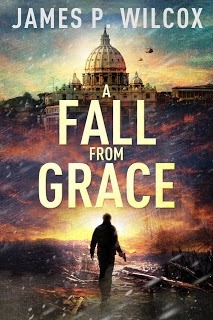 After Father Reed is found dead in Philadelphia, David is sent by the Vatican to assist Detective Peter O'Malley in the murder investigation. What they find is a terrorist plot to unleash a jihad against the Catholic Church in America.Racing against time, David and O’Malley try to prevent a holy war. When his mother and his former girlfriend become targets, David discovers just how far he will go to protect his loved ones and his Church.
After Father Reed is found dead in Philadelphia, David is sent by the Vatican to assist Detective Peter O'Malley in the murder investigation. What they find is a terrorist plot to unleash a jihad against the Catholic Church in America.Racing against time, David and O’Malley try to prevent a holy war. When his mother and his former girlfriend become targets, David discovers just how far he will go to protect his loved ones and his Church.Excerpt A dry and blistered hand, with skin browned by near continual exposure to the sun, reaches out and grasps the scorching metal barrel of the AK-47 Russian-made machine gun. Giving the barrel a quick tug, the strap settles more comfortably across his back. Rolling his shoulders beneath the familiar weight of the weapon, Saladin pulls on the reins and then reaches into the saddlebag riding along the rich chocolate brown of his Arabian’s right flank, and pulls out a pair of Bushnell Legend Ultra HD binoculars. Lifting them to his eyes, he scans the barren valley that stretches out in front of him, concentrating on the cluster of five mud huts built along the face of the mountain cliffs, which run along the eastern length of the valley.
Seen from an elevation of eight hundred feet, the village, if it can be called a village, appears deserted, but Saladin knows what to look for. After slowly scanning the valley from north to south, Saladin makes a slight adjustment to the focus and then settles in for a long look at the largest hut. After ten minutes, his patience is rewarded by a brief glimpse of the midnight black hair of a horse’s tail swishing past the northeastern corner of the hut. Pulling the binoculars from his eyes, Saladin tucks them back into his pack before standing in the stirrups and swinging his left leg over the beast’s rump, deliberately climbing off his horse’s back. A smile creeps across his face as he begins leading the animal down the barely discernible track among the rocks to the valley floor.Quickly dropping down below the reach of the sun, Saladin shivers against the chill contained within the valley’s shadow. Dressed in the salwar kameez—traditional Afghan clothing consisting of baggy white cotton trousers, which stop just above the ankles, and a loose-fitting forest-green tunic, which ends just above the knee—and his pakol, the wide wool hat encircled by a thick rolled brim made famous by the Mujahedeen during their war with the Soviets, he considers wrapping himself in his patoos, warm wool blanket, before moving deeper into the valley.“Allahu Akbar,” he whispers to himself, ignoring the chill, while quickening his pace toward his destination.
Moving among the rocks, Saladin runs his upcoming meeting, the meeting in which he will change the course of Western history, through his mind. As the undisputed leader of the Ghazwa, a secretive group of terrorists and assassins whose name specifically refers to the battles led by the Prophet Muhammad, Saladin has the power to compel select imam, mullahs and militia chieftains from across the Middle East to gather in this remote location in Nangarhar’s rugged Khogyani district. As the planner and financier of most terrorist activity in the Middle East, he has the right to announce the next phase of jihad, holy war, against Islam’s Western enemies.
Links
Amazon
FacebookInstagramWebsiteGoodreads
Twitter: @m16agenda
Published on September 21, 2017 21:25
September 17, 2017
SPECIAL FEATURE: The Mystery of a Setting
 Joyce T. Strand, AuthorI started to write mystery novels in 2009. Those of you who follow me know that I selected the genre based on my love of reading all types of mysteries or suspense thrillers—noir, spy, cozy, hard-boiled, contemporary, historical.
Joyce T. Strand, AuthorI started to write mystery novels in 2009. Those of you who follow me know that I selected the genre based on my love of reading all types of mysteries or suspense thrillers—noir, spy, cozy, hard-boiled, contemporary, historical. In a previous post, I divulged that for me the first step in writing a mystery is to develop the character/sleuth who would drive the plot.
The second most important element is selecting a setting—a place and time in which to place my sleuth. All eight of my published mysteries have been set in California—San Francisco in 1912, Ventura in 1939 and contemporary Silicon Valley and Sonoma wine country.
My ninth mystery, coming in November 2017, is set in a small rural town in Southern California near San Diego—an area that offers a wide spectrum of events and interesting locales.
The following article explains how and why I selected this location—aside from the fact that I live there!
The Mystery of a Setting
Setting can drive a mystery, its sleuth, or its villains—and even become a character itself.
The elements of a mystery plot—sleuth/protagonist, setting, villain/antagonist, red herrings, crime—blend together to create the puzzle for readers to put together piece by piece, chapter by chapter. They all contribute.
I always begin my mysteries with my sleuth. However, I have also discovered that the time period and location can help drive the plot and develop my characters.
When I turned to some of my favorite mysteries, I quickly learned that many successful authors have done the same—they use setting to develop their characters and the mystery.
An outstanding example is Agatha Christie’s Murder on the Orient Express. The famous detective Hercule Poirot has to solve a murder and learn about the characters—from a moving train. Another example is Dick Francis who set his thrillers around horse racing in the UK. His amateur sleuths—often jockeys—must solve horse-related crimes.
Even procedurals are often heavily influenced by their surroundings – Los Angeles is prevalent in Michael Connelly’s Harry Bosch mysteries. And we usually envisage Mickey Spillane in L.A. Or think about Sherlock Holmes in foggy London. And it’s likely Quebec comes to mind when we envision Louise Penny’s Chief Inspector Armand Gamache solving murders. And how does Nero Wolfe manage to solve all those crimes never leaving his office?
 Therefore when it came time to start a new trilogy with a new amateur sleuth I considered the setting carefully.
Therefore when it came time to start a new trilogy with a new amateur sleuth I considered the setting carefully.My new sleuth, Emily Lazzaro, is the daughter of the Sonoma winemaker in my earlier Brynn Bancroft mysteries. She grew up in the wine region of Sonoma learning about winemaking. It turns out that she wants to work in the hospitality industry, in which she has earned a degree. So when her fiancé invites her to move to an up-and-coming wine region near San Diego, she readily agreed believing that she could be in charge of managing a winery.


By placing her in Ramona, Calif., she comes to appreciate the potential of a rural equestrian community with a wine industry, a hefty artist community, growing restaurants, picturesque rocky views, fresh produce—all located within forty minutes of downtown San Diego. Given the blending of these features, she decides she wants to live there. However, when she breaks up with her fiancé she realizes she needs to make some changes to create a living enabling her to stay.
This heightens her hospitality instincts as she searches for a better paying job, and also enables the introduction of red herrings and plot complications specific to the region that draw her deeper into the mystery.
She becomes involved in a murder, a love interest who doesn’t trust her, a new enterprise, and other Dangerous Changes in her life so that she can live in what has become to her a special town.
suspicious “friends”—all in order to make the
As the plot evolves so does Emily—driven by her own background and characteristics—but also by the setting. Events and happenings in her chosen community mold the changes she needs to make.
Bottom line: by using an intriguing locale and time period readers become engaged more with the characters and are drawn deeper into solving the mystery.
Published on September 17, 2017 18:43



